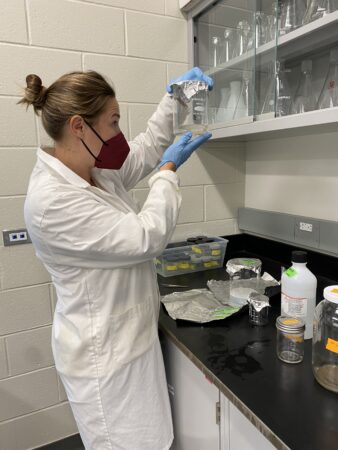
New study finds microplastics in several protein foods
By Food in Canada Staff
Food Safety Packaging Processing Plant-based foods Meat &Poultry Seafood Editor pick Ocean Conservancy Plastic pollution University of Toronto Co-author Madeleine Milne doing research at the University of Toronto.
Co-author Madeleine Milne doing research at the University of Toronto. A new study led by researchers at Ocean Conservancy and the University of Toronto found microplastic particles in 88 per cent of protein food samples tested. The samples were drawn from 16 different protein types destined for U.S. consumers.
Protein types included store-purchased breaded shrimp, minced pollock, fish sticks, white Gulf shrimp (headless/shell-on), Key West pink shrimp (headless/shell-on), Alaska Pollock fillets (skinless), chicken nuggets, top sirloin steaks, pork loin chops, chicken breasts, plant-based nuggets, plant-based fish sticks, plant-based ground beef, and tofu blocks.
While scientists have long documented the presence of microplastics in the digestive tracts of commercial fish and shellfish like salmon, halibut and oysters, there has been little research into whether these microplastics are entering the filets of the fish – the parts that are actually eaten by people; and little research into terrestrial protein sources like beef and chicken that make up a large part of the American diet. In this study, microplastics were found in all 16 protein types tested, suggesting humans are likely eating microplastics no matter the source of protein they choose. Further, there were no statistical differences in microplastic concentrations between land- and ocean-sourced proteins.
“This is a startling reminder of just how prolific plastic pollution has become – humans live on land and yet, seafood samples are just as likely to be contaminated with plastics as are terrestrial-derived proteins,” said study co-author Dr. Britta Baechler, a marine biologist and associate director of Plastics Science at Ocean Conservancy. “There’s no escaping them no matter what you eat, it seems. The plastic pollution crisis is impacting all of us, and we need to take action to address its many forms.”
The study found evidence that food processing is a likely source of microplastic contamination, as highly processed protein products (e.g. fish sticks, chicken nuggets, tofu, and plant-based burgers, among others) contained significantly more microplastics per gram than minimally processed products (e.g. packaged wild Alaska pollock, raw chicken breast, and others). However, no statistical difference was found between high-processed products and fresh-caught products, suggesting food processing is not the only source of microplastic contamination and opening avenues for further research.
“It’s tempting to want to draw conclusions like ‘eat less of this and more of that’ to avoid microplastics in your diet; but right now we still know very little about the microplastic burdens in commonly consumed foods. Our study adds to this knowledge but also demonstrates the need for further research to better understand the bigger picture, including where these microplastics are coming from and the potential human health risks,” said primary co-author Madeleine Milne, who conducted the research while at the Rochman Lab at the University of Toronto in 2022.
Notably, across all samples, nearly half (44 per cent) of the identified microplastics were fibres, which is consistent with other studies suggesting that fibres are the most prevalent form of microplastic in the environment. About a third of the microplastics (30 per cent) were plastic fragments.
Using survey data from a separate study by Ocean Conservancy and the University of Toronto (to be published in Frontiers in Marine Science), the authors estimate an American adult will consume, on average, 11,500 microplastics per year. Annual exposure could be as high as 3.8 million microplastics per year if calculated using the highest levels of microplastics found in each individual protein type and the average reported protein consumption rates.
“As ocean scientists, my co-authors and I are deeply concerned about the growing plastics crisis in the world’s ocean,” said Dr. George Leonard, Ocean Conservancy’s chief scientist and a co-author of the study. “But our study shows that plastics in our food goes well beyond fish and shellfish to a wide variety of other protein sources, as well. Our work is a call to action to reduce plastic pollution in its many forms to ensure a safe and healthy food supply for all consumers.”
Print this page